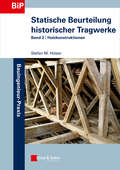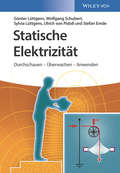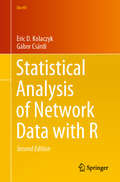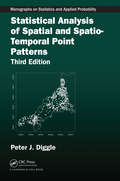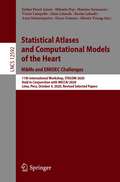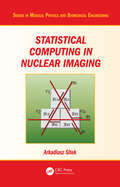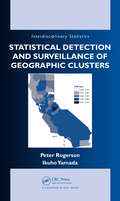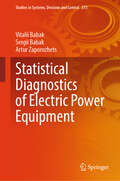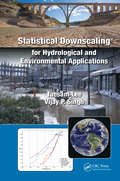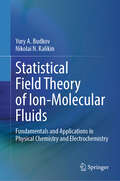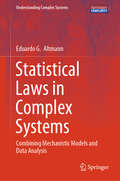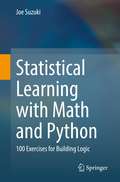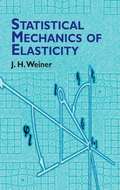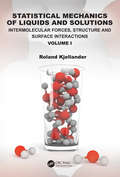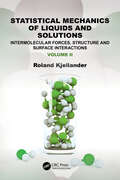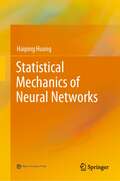- Table View
- List View
Statische Beurteilung historischer Tragwerke: Band 2 - Holzkonstruktionen (Bauingenieur-Praxis)
by Stefan HolzerDie Aufgabe der Beurteilung existierender Tragwerke stellt sich bei Umbauten oder Umnutzungen, und zunehmend auch bei der Einschätzung der Standsicherheit von öffentlich zugänglichen Bauwerken. Bei realistischer Beurteilung können Tragreserven durch Reparaturmaßnahmen aktiviert und somit die Eingriffeauf ein Mindestmaß begrenzt werden, was besonders unter denkmalpflegerischen Randbedingungen erwünscht ist. In Band 2 werden die handwerklichen Holztragwerke Mitteleuropas untersucht. Das Buch führt kurz in den Holzwerkstoff ein. Die grundsätzliche Vorgehensweise bei der Bestandsuntersuchung wird dargelegt, auch im Hinblick auf Identifikation und Datierung historischer Schäden und Reparaturen. Handnahe Untersuchungen und zerstörungsfreie Prüfungen werden erläutert, ebenso wie die Grundlagen der Standsicherheitsbeurteilung von Tragwerken mit langer Standzeit. Den Hauptteil des Werkes nimmt die detaillierte Diskussion der Konstruktionssysteme und Anschlüsse historischer Decken- und Dachtragwerke ein; das Tragverhalten wird an überaus zahlreichen Berechnungsbeispielen erläutert.
Statische Elektrizität: Durchschauen - Überwachen - Anwenden
by Günter Lüttgens Sylvia Lüttgens Wolfgang Schubert Ulrich von Pidoll Stefan EmdeVerständnis und Kontrolle statischer Elektrizität sind von elementarer Bedeutung in vielen Industriezweigen, in erster Linie mit Blick auf die potentiellen Gefahren. Daher sind die Erkennung und Vermeidung von Gefahren durch statische Aufladungen immer wichtiger geworden und haben die Entwicklung neuer und präziser Messmethoden befördert. Andererseits können statische Aufladungen auch nutzbringend eingesetzt werden. Vielfältige Anwendungen werden beschrieben. Statische Elektrizität ? Durchschauen ? Überwachen ? Anwenden informiert zunächst über Brand- und Explosionsgefahren. Entstehung von Aufladung und daraus resultierende Entladungserscheinungen werden veranschaulicht. Ein großer Teil des Buches befasst sich mit Messtechnik, Vermeidung von Gefahren und Störungen sowie Beseitigung unerwünschter Aufladung. Fallstudien und Beschreibung von Demonstrationsexperimenten vermitteln den Bezug zur Praxis. Ohne Normen geht es nicht; auch darüber wird berichtet. Der stetig zunehmenden Anwendung statischer Elektrizität ist ein eigenes Kapitel über den gezielten Einsatz von Aufladungen vorbehalten und soll die Kreativität der Leser anregen. Zu guter Letzt sind im Mathematischen Werkzeugkasten alle relevanten Formeln einsortiert. * Praxisperspektive: geschrieben von Autoren mit langjähriger Forschungs- und Beratungserfahrung * Durchblick: Beschreibung von Demonstrationsexperimenten zur besseren Veranschaulichung * Fallstudien: aus den Fehlern Anderer lernen * Zusatzmaterial: kurze Videos zeigen die - teils drastischen - Auswirkungen statischer Aufladungen
Statistical Analysis of Network Data with R (Use R! #65)
by Eric D. Kolaczyk Gábor CsárdiThe new edition of this book provides an easily accessible introduction to the statistical analysis of network data using R. It has been fully revised and can be used as a stand-alone resource in which multiple R packages are used to illustrate how to conduct a wide range of network analyses, from basic manipulation and visualization, to summary and characterization, to modeling of network data. The central package is igraph, which provides extensive capabilities for studying network graphs in R. The new edition of this book includes an overhaul to recent changes in igraph. The material in this book is organized to flow from descriptive statistical methods to topics centered on modeling and inference with networks, with the latter separated into two sub-areas, corresponding first to the modeling and inference of networks themselves, and then, to processes on networks. The book begins by covering tools for the manipulation of network data. Next, it addresses visualization and characterization of networks. The book then examines mathematical and statistical network modeling. This is followed by a special case of network modeling wherein the network topology must be inferred. Network processes, both static and dynamic are addressed in the subsequent chapters. The book concludes by featuring chapters on network flows, dynamic networks, and networked experiments. Statistical Analysis of Network Data with R, 2nd Ed. has been written at a level aimed at graduate students and researchers in quantitative disciplines engaged in the statistical analysis of network data, although advanced undergraduates already comfortable with R should find the book fairly accessible as well.
Statistical Analysis of Noise in MRI
by Santiago Aja-Fernández Gonzalo Vegas-Sánchez-FerreroThis unique text presents a comprehensive review of methods for modeling signal and noise in magnetic resonance imaging (MRI), providing a systematic study, classifying and comparing the numerous and varied estimation and filtering techniques. Features: provides a complete framework for the modeling and analysis of noise in MRI, considering different modalities and acquisition techniques; describes noise and signal estimation for MRI from a statistical signal processing perspective; surveys the different methods to remove noise in MRI acquisitions from a practical point of view; reviews different techniques for estimating noise from MRI data in single- and multiple-coil systems for fully sampled acquisitions; examines the issue of noise estimation when accelerated acquisitions are considered, and parallel imaging methods are used to reconstruct the signal; includes appendices covering probability density functions, combinations of random variables used to derive estimators, and useful MRI datasets.
Statistical Analysis of Profile Monitoring
by Amirhossein Amiri Rassoul Noorossana Abbas SaghaeiA one-of-a-kind presentation of the major achievements in statistical profile monitoring methodsStatistical profile monitoring is an area of statistical quality control that is growing in significance for researchers and practitioners, specifically because of its range of applicability across various service and manufacturing settings. Comprised of contributions from renowned academicians and practitioners in the field, Statistical Analysis of Profile Monitoring presents the latest state-of-the-art research on the use of control charts to monitor process and product quality profiles. The book presents comprehensive coverage of profile monitoring definitions, techniques, models, and application examples, particularly in various areas of engineering and statistics.The book begins with an introduction to the concept of profile monitoring and its applications in practice. Subsequent chapters explore the fundamental concepts, methods, and issues related to statistical profile monitoring, with topics of coverage including:Simple and multiple linear profilesBinary response profilesParametric and nonparametric nonlinear profilesMultivariate linear profiles monitoringStatistical process control for geometric specificationsCorrelation and autocorrelation in profilesNonparametric profile monitoringThroughout the book, more than two dozen real-world case studies highlight the discussed topics along with innovative examples and applications of profile monitoring. Statistical Analysis of Profile Monitoring is an excellent book for courses on statistical quality control at the graduate level. It also serves as a valuable reference for quality engineers, researchers and anyone who works in monitoring and improving statistical processes.
Statistical Analysis of Spatial and Spatio-Temporal Point Patterns (ISSN)
by Peter J. DiggleRetaining all the material from the second edition and adding substantial new material, this third edition presents models and statistical methods for analyzing spatially referenced point process data. Reflected in the title, this edition now covers spatio-temporal point patterns. It also incorporates the use of R through several packages dedicated to the analysis of spatial point process data, with code and data sets available online. Practical examples illustrate how the methods are applied to analyze spatial data in the life sciences.
Statistical Atlases and Computational Models of the Heart. M&Ms and EMIDEC Challenges: 11th International Workshop, STACOM 2020, Held in Conjunction with MICCAI 2020, Lima, Peru, October 4, 2020, Revised Selected Papers (Lecture Notes in Computer Science #12592)
by Oscar Camara Mihaela Pop Maxime Sermesant Alistair Young Alain Lalande Avan Suinesiaputra Esther Puyol Anton Victor Campello Karim LekadirThis book constitutes the proceedings of the 11th International Workshop on Statistical Atlases and Computational Models of the Heart, STACOM 2020, as well as two challenges: M&Ms - The Multi-Centre, Multi-Vendor, Multi-Disease Segmentation Challenge, and EMIDEC - Automatic Evaluation of Myocardial Infarction from Delayed-Enhancement Cardiac MRI Challenge. The 43 full papers included in this volume were carefully reviewed and selected from 70 submissions. They deal with cardiac imaging and image processing, machine learning applied to cardiac imaging and image analysis, atlas construction, artificial intelligence, statistical modelling of cardiac function across different patient populations, cardiac computational physiology, model customization, atlas based functional analysis, ontological schemata for data and results, integrated functional and structural analyses, as well as the pre-clinical and clinical applicability of these methods.
Statistical Computing in Nuclear Imaging (ISSN #32)
by Arkadiusz SitekStatistical Computing in Nuclear Imaging introduces aspects of Bayesian computing in nuclear imaging. The book provides an introduction to Bayesian statistics and concepts and is highly focused on the computational aspects of Bayesian data analysis of photon-limited data acquired in tomographic measurements. Basic statistical concepts, elements of
Statistical Design of Experiments with Engineering Applications
by Kamel Rekab Muzaffar ShaikhIn today's high-technology world, with flourishing e-business and intense competition at a global level, the search for the competitive advantage has become a crucial task of corporate executives. Quality, formerly considered a secondary expense, is now universally recognized as a necessary tool. Although many statistical methods are available for
Statistical Detection and Surveillance of Geographic Clusters (Chapman & Hall/CRC Interdisciplinary Statistics)
by Peter Rogerson Ikuho YamadaThe widespread popularity of geographic information systems (GIS) has led to new insights in countless areas of application. It has facilitated not only the collection and storage of geographic data, but also the display of such data. Building on this progress by using an integrated approach, Statistical Detection and Monitoring of Geographic Clust
Statistical Diagnostics of Electric Power Equipment (Studies in Systems, Decision and Control #573)
by Artur Zaporozhets Vitalii Babak Sergii BabakThis book considers the issues of constructing mathematical probabilistic models of diagnostic signals, the development of statistical methods of their analysis in order to make diagnostic decisions and, finally, the technical implementation of the proposed diagnostic methods. Following the concept of primacy of the mathematical model of the diagnostic signal, the authors considered it expedient to consider first of all the questions connected with the theory of random processes possessing infinitely divisible distribution laws, linear and linear periodic random processes. Considerable attention is paid to the issues of simulation modeling of diagnostic signals and their statistical evaluation. Modern element base and new information technologies allowed to develop, build and practically test a number of experimental samples of information-measuring systems of statistical diagnostics of electric power engineering objects. Among these IMS, the systems are realized by means of unmanned diagnostic complexes, and also IMS of vibrodiagnostics of moving units of electric machines represents an important role. A large amount of experimental research has shown the operability and efficiency of the built IMS samples. Particular attention is paid to the selection of diagnostic spaces, formation of training sets, construction of solving rules for diagnosis and classification of EE defects. The authors do not pretend to a comprehensive consideration of the issues of EE diagnostics using statistical methods and IMS realized on their basis. At the same time, the results of researches, stated in this monograph, were a natural continuation of the subject of application of statistical methods in the field of control, monitoring and diagnostics for objects of electric power industry.
Statistical Downscaling for Hydrological and Environmental Applications
by Vijay P. Singh Taesam LeeGlobal climate change is typically understood and modeled using global climate models (GCMs), but the outputs of these models in terms of hydrological variables are only available on coarse or large spatial and time scales, while finer spatial and temporal resolutions are needed to reliably assess the hydro-environmental impacts of climate change. To reliably obtain the required resolutions of hydrological variables, statistical downscaling is typically employed. Statistical Downscaling for Hydrological and Environmental Applications presents statistical downscaling techniques in a practical manner so that both students and practitioners can readily utilize them. Numerous methods are presented, and all are illustrated with practical examples. The book is written so that no prior background in statistics is needed, and it will be useful to graduate students, college faculty, and researchers in hydrology, hydroclimatology, agricultural and environmental sciences, and watershed management. It will also be of interest to environmental policymakers at the local, state, and national levels, as well as readers interested in climate change and its related hydrologic impacts. Features: Examines how to model hydrological events such as extreme rainfall, floods, and droughts at the local, watershed level. Explains how to properly correct for significant biases with the observational data normally found in current Global Climate Models (GCMs). Presents temporal downscaling from daily to hourly with a nonparametric approach. Discusses the myriad effects of climate change on hydrological processes.
Statistical Electromagnetics (Electromagnetics Library)
by Richard HollandThis book addresses the problem of treating interior responses of complex electronic enclosures or systems, and presents a probabilistic approach. Relationships for determining the statistics of the driving fields to apply to a circuit analysis code representing part of an enclosed system's writing are worked out. Also addressed are limited spatial and frequency coherence essential to a statistically based field drive model. This text gives examples, different modeling, and describes how to make, interchange, and optimize models.
Statistical Field Theory of Ion-Molecular Fluids: Fundamentals and Applications in Physical Chemistry and Electrochemistry
by Yury A. Budkov Nikolai N. KalikinThis book presents statistical physics methods based on self-consistent field theory for describing the thermodynamic properties of ion-molecular systems, including electrolyte solutions, ionic liquids, polymeric ionic liquids, and metal-organic complexes. The methods are applicable in both the bulk and at interfaces, taking into account the molecular structure of these systems. The book also provides a comprehensive analysis of the current state of art on statistical field theory for ion-molecular systems. It is primarily intended for researchers and graduate students in physical chemistry and condensed matter physics, as well as for physical chemists, physicists, and engineers interested in molecular system theory and simulation. By presenting these approaches, the book aims to enable readers to solve various problems in physical chemistry and electrochemistry using the methods described. The authors attempted to focus on specific issues and provide the necessary theoretical background. The book includes a mathematical introduction that readers can consult if they need clarification on any mathematical concepts or details omitted in the main text. In order to read the book, it is recommended that readers have a basic understanding of calculus, linear algebra, and probability theory, which can be acquired through standard university courses.
Statistical Geoinformatics for Human Environment Interface (Chapman & Hall/CRC Applied Environmental Statistics)
by Wayne L. Myers Ganapati P. PatilStatistical Geoinformatics for Human Environment Interface presents two paradigms for studying both space and interface with regard to human/environment: localization and multiple indicators. The first approach localizes thematic targets by treating space as a pattern of vicinities, with the pattern being a square grid and the placement of viciniti
Statistical Inference for Engineers and Data Scientists
by Pierre Moulin Venugopal VeeravalliThis book is a mathematically accessible and up-to-date introduction to the tools needed to address modern inference problems in engineering and data science, ideal for graduate students taking courses on statistical inference and detection and estimation, and an invaluable reference for researchers and professionals. With a wealth of illustrations and examples to explain the key features of the theory and to connect with real-world applications, additional material to explore more advanced concepts, and numerous end-of-chapter problems to test the reader's knowledge, this textbook is the 'go-to' guide for learning about the core principles of statistical inference and its application in engineering and data science. The password-protected solutions manual and the image gallery from the book are available online.
Statistical Inference for Financial Engineering
by Masanobu Taniguchi Tomoyuki Amano Hiroaki Ogata Hiroyuki TaniaiThis monograph provides the fundamentals of statistical inference for financial engineering and covers some selected methods suitable for analyzing financial time series data. In order to describe the actual financial data, various stochastic processes, e. g. non-Gaussian linear processes, non-linear processes, long-memory processes, locally stationary processes etc. are introduced and their optimal estimation is considered as well. This book also includes several statistical approaches, e. g. , discriminant analysis, the empirical likelihood method, control variate method, quantile regression, realized volatility etc. , which have been recently developed and are considered to be powerful tools for analyzing the financial data, establishing a new bridge between time series and financial engineering. This book is well suited as a professional reference book on finance, statistics and statistical financial engineering. Readers are expected to have an undergraduate-level knowledge of statistics.
Statistical Laws in Complex Systems: Combining Mechanistic Models and Data Analysis (Understanding Complex Systems)
by Eduardo G. AltmannThis book provides a unifying approach to the study of statistical laws, critically evaluating their role in the theoretical understanding of complex systems and the different data-analysis methods used to evaluate them. Statistical laws describe regular patterns observed in diverse scientific domains, ranging from the magnitude of earthquakes (Gutenberg-Richter law) and metabolic rates in organisms (Kleiber's law), to the frequency distribution of words in texts (Zipf's and Herdan-Heaps' laws), and productivity metrics of cities (urban scaling laws). The origins of these laws, their empirical validity, and the insights they provide into underlying systems have been subjects of scientific inquiry for centuries. Through a historical review and a unified analysis, this book argues that the persistent controversies on the validity of statistical laws are predominantly rooted not in novel empirical findings but in the discordance among data-analysis techniques, mechanistic models, and the interpretations of statistical laws. Starting with simple examples and progressing to more advanced time-series and statistical methods, this book and its accompanying repository provide comprehensive material for researchers interested in analyzing data, testing and comparing different laws, and interpreting results in both existing and new datasets.
Statistical Learning with Math and Python: 100 Exercises for Building Logic
by Joe SuzukiThe most crucial ability for machine learning and data science is mathematical logic for grasping their essence rather than knowledge and experience. This textbook approaches the essence of machine learning and data science by considering math problems and building Python programs. As the preliminary part, Chapter 1 provides a concise introduction to linear algebra, which will help novices read further to the following main chapters. Those succeeding chapters present essential topics in statistical learning: linear regression, classification, resampling, information criteria, regularization, nonlinear regression, decision trees, support vector machines, and unsupervised learning. Each chapter mathematically formulates and solves machine learning problems and builds the programs. The body of a chapter is accompanied by proofs and programs in an appendix, with exercises at the end of the chapter. Because the book is carefully organized to provide the solutions to the exercises in each chapter, readers can solve the total of 100 exercises by simply following the contents of each chapter. This textbook is suitable for an undergraduate or graduate course consisting of about 12 lectures. Written in an easy-to-follow and self-contained style, this book will also be perfect material for independent learning.
Statistical Machine Learning: A Unified Framework (Chapman & Hall/CRC Texts in Statistical Science)
by Richard GoldenThe recent rapid growth in the variety and complexity of new machine learning architectures requires the development of improved methods for designing, analyzing, evaluating, and communicating machine learning technologies. Statistical Machine Learning: A Unified Framework provides students, engineers, and scientists with tools from mathematical statistics and nonlinear optimization theory to become experts in the field of machine learning. In particular, the material in this text directly supports the mathematical analysis and design of old, new, and not-yet-invented nonlinear high-dimensional machine learning algorithms. Features: Unified empirical risk minimization framework supports rigorous mathematical analyses of widely used supervised, unsupervised, and reinforcement machine learning algorithms Matrix calculus methods for supporting machine learning analysis and design applications Explicit conditions for ensuring convergence of adaptive, batch, minibatch, MCEM, and MCMC learning algorithms that minimize both unimodal and multimodal objective functions Explicit conditions for characterizing asymptotic properties of M-estimators and model selection criteria such as AIC and BIC in the presence of possible model misspecification This advanced text is suitable for graduate students or highly motivated undergraduate students in statistics, computer science, electrical engineering, and applied mathematics. The text is self-contained and only assumes knowledge of lower-division linear algebra and upper-division probability theory. Students, professional engineers, and multidisciplinary scientists possessing these minimal prerequisites will find this text challenging yet accessible. About the Author: Richard M. Golden (Ph.D., M.S.E.E., B.S.E.E.) is Professor of Cognitive Science and Participating Faculty Member in Electrical Engineering at the University of Texas at Dallas. Dr. Golden has published articles and given talks at scientific conferences on a wide range of topics in the fields of both statistics and machine learning over the past three decades. His long-term research interests include identifying conditions for the convergence of deterministic and stochastic machine learning algorithms and investigating estimation and inference in the presence of possibly misspecified probability models.
Statistical Mechanics for Chemistry and Materials Science
by Biman BagchiThis book covers the broad subject of equilibrium statistical mechanics along with many advanced and modern topics such as nucleation, spinodal decomposition, inherent structures of liquids and liquid crystals. Unlike other books on the market, this comprehensive text not only deals with the primary fundamental ideas of statistical mechanics but also covers contemporary topics in this broad and rapidly developing area of chemistry and materials science.
Statistical Mechanics of Elasticity
by J. H. WeinerAdvanced, self-contained treatment illustrates general principles and elastic behavior of solids. Part 1, based on classical mechanics, studies thermoelastic behavior of crystalline and polymeric solids. Part 2, based on quantum mechanics, focuses on interatomic force laws, behavior of solids, and thermally activated processes. 96 figures. 1983 edition.
Statistical Mechanics of Liquids and Solutions: Intermolecular Forces, Structure and Surface Interactions
by Roland KjellanderThe statistical mechanical theory of liquids and solutions is a fundamental area of physical sciences with important implications for many industrial applications. This book shows how you can start from basic laws for the interactions and motions of microscopic particles and calculate how macroscopic systems of these particles behave, thereby explaining properties of matter at the scale that we perceive. Using this microscopic, molecular approach, the text emphasizes clarity of physical explanations for phenomena and mechanisms relevant to fluids, addressing the structure and behavior of liquids and solutions under various conditions. A notable feature is the author’s treatment of forces between particles that include nanoparticles, macroparticles, and surfaces. The book also provides an expanded, in-depth treatment of polar liquids and electrolytes.
Statistical Mechanics of Liquids and Solutions: Intermolecular Forces, Structure and Surface Interactions
by Roland KjellanderThe statistical mechanical theory of liquids and solutions is a fundamental area of physical sciences with important implications in other fields of science and industrial applications. Statistical Mechanics of Liquids and Solutions: Intermolecular Forces, Structure and Surface Interactions is the second in a series of two on this subject. While the first volume introduced equilibrium statistical mechanics in general and statistical mechanics of liquids and solutions at an introductory level, the present volume presents an advanced treatment of the subject and penetrates much deeper into liquid state theory.A major theme in both books is the intimate relationship between forces in a fluid and the fluid structure - a relationship that is paramount for the understanding of the subject of interactions in dense fluids. Using this microscopic, molecular approach, the text emphasizes clarity of physical explanations for phenomena and mechanisms relevant to fluids, addressing the structure and behavior of liquids and solutions under various conditions. A notable feature is the author's treatment of intermolecular interactions in liquids and solutions that include interactions between nanoparticles, macroparticles, and surfaces. The book provides an in-depth treatment of simple liquids, molecular fluids, particle dispersions, dense ionic fluids and electrolyte solutions with molecular solvent, both in the bulk and in confinement. It contains a unified exact treatment of electrolyte solutions, ionic liquids and polar fluids as well as approximate theories and applications.Statistical Mechanics of Liquids and Solutions will be an invaluable resource for graduate and postgraduate students in physics, chemistry, soft matter science, surface and colloid science and related fields, as well as professionals and instructors in those areas of science.
Statistical Mechanics of Neural Networks
by Haiping HuangThis book highlights a comprehensive introduction to the fundamental statistical mechanics underneath the inner workings of neural networks. The book discusses in details important concepts and techniques including the cavity method, the mean-field theory, replica techniques, the Nishimori condition, variational methods, the dynamical mean-field theory, unsupervised learning, associative memory models, perceptron models, the chaos theory of recurrent neural networks, and eigen-spectrums of neural networks, walking new learners through the theories and must-have skillsets to understand and use neural networks. The book focuses on quantitative frameworks of neural network models where the underlying mechanisms can be precisely isolated by physics of mathematical beauty and theoretical predictions. It is a good reference for students, researchers, and practitioners in the area of neural networks.
